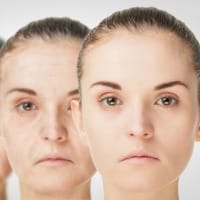University of Maryland researchers have found that a fairly common chemical may slow the aging process of human skin. The chemical, an antioxidant known as methylene blue, is completely safe and affordable. The research team found evidence that this chemical may also even completely reverse the most common signs of aging. They tested cultured skin cells along with simulated skin tissue. It is possible this chemical will eventually be used as an antioxidant in a number of different skin care products. The study was led by senior author Kan Cao. He is an associate professor of molecular genetics and cell biology at the University of Maryland. The details of the study were recently published online in the journal Scientific Reports.
About the Study
The research team tested methylene blue for nearly an entire month in skin cells taken from healthy donors. These individuals were middle-aged. Skin cells from those who suffer from progeria were also tested. Progeria is a genetic disease that copies the aging process at a heightened rate. The research team tested three additional antioxidants in addition to methylene blue: MitoTEMPO (mTEM), MitoQ and N-Acetyl-L-Cysteine.
Methylene blue outperformed the other antioxidants in the experiments. It boosted numerous age-related cell symptoms in progeria patients as well as the healthy donors. The skin cells exhibited a reduction in harmful molecules called “reactive oxygen species”, a decrease in cell death rates and a bump in cell division rates across the four-week treatment period.
Cao’s research team also tested methylene blue in skin cells from older individuals. These donors were 80 years-old or older. Their skin cells were tested for a four-week period. Once treatment culminated, the cells from the comparably old donors endured a wide array of improvements like the diminished expression of two genes (senescence-associated p16 and beta-galactosidase) used to indicate cell aging.
A Closer Look at the Results
Cao reports the effects of methylene blue are not temporary. This chemical produces long-lasting and fundamental alterations to skin cells for skin of all ages. The study’s lead author, Zheng-Mei Xiong, states he was excited to see skin cells taken from individuals beyond 80 years of age grow far better in the medium containing methylene blue with lower cell senescence markers. Xiong is an assistant research professor of molecular genetics and cell biology at the University of Maryland.
About the Simulated Human Skin Used in the Experiments
The research team used simulated human skin to conduct even more tests. The simulated skin is a 3D model comprised of living skin cells. It is made of all the primary structures and layers of skin tissue but for sweat glands and hair follicles. This model skin is also usable in skin irritation tests mandated by the Food and Drug Administration in order to approve cosmetic products that are poised to hit the market.
The simulated skin empowered the research group to test all sorts of different aging symptoms that could not be replicated within cultured cells. It is interesting to note the simulated skin treated with methylene blue held onto more water and became thicker. Both of these characteristics are typical of youthful skin. The simulated skin was also used to gauge the safety of cosmetic ointments with added methylene blue. The results indicate methylene blue spurs minimal irritation even at especially high concentrations.
What’s Next
Cao and Xiong are working on ways for people to enjoy the benefits of methylene blue’s unique properties. The research team has already started the formulation of cosmetics with this chemical. They hope to bring products to the market in the near future.




